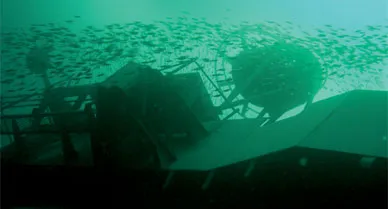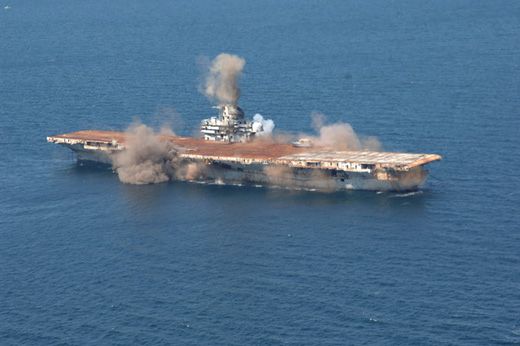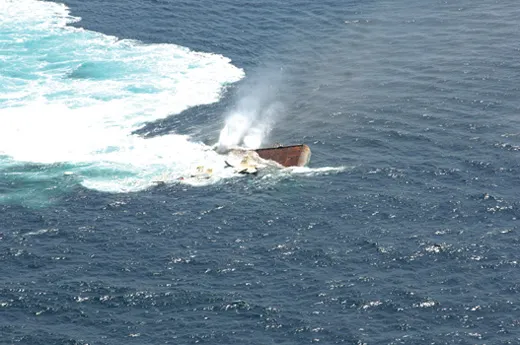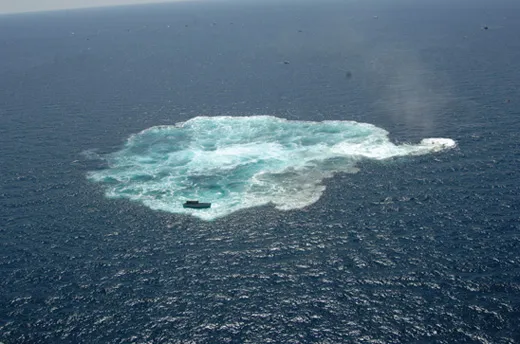R.I.P., Mighty O
A fabled aircraft carrier sunk deliberately off the coast of Florida is the world’s largest artificial reef
Under tow and making barely two knots, the USS Oriskany seemed a shell of its former self. Once, it had been, to paraphrase John Paul Jones, a fast ship, going in harm's way. Now it was a derelict, old and crippled, its bulkheads stained with patches of rust that could have been lesions. Near where the mouth of the bay opens into the Gulf of Mexico, a tugboat nudged the ship around, and it was possible to appreciate its size—almost three football fields long and nearly 20 stories tall.
Next to it, the salvage craft, tugs and Coast Guard patrol boats escorting it looked like nervous water bugs.
Several people stood on a beach near Pensacola Pass to see the old carrier off. Some had come a long way, and their memories went back many years to when they were young and the ship had been home. Two men were shooting video footage. Had they served on the ship? Yes, they said, in the late 1960s, off North Vietnam.
Did you come far?
"He came from Michigan, and I came from Pennsylvania," one said. "We're old shipmates. No way we would have missed this."
The Oriskany—named for a bloody Revolutionary War battle—was launched in 1945, too late to fight in the war that had secured aircraft carriers' place in military history. But the Oriskany went on to serve as a floating airfield off the Korean Peninsula. There was plenty of risk and little glory in the work, and when the war was over the ship did its part capturing this truth on film. Many scenes in The Bridges at Toko-Ri—the 1954 film about a reserve aviator (William Holden) called up from civilian life to fly combat missions over Korea—were shot aboard it.
After Korea, the Oriskany, known to some as the Mighty O, was modernized and routinely deployed to the Western Pacific. It had just returned from duty in the South China Sea when, in August 1964, Navy destroyers reported they were under attack by North Vietnamese torpedo boats in the Gulf of Tonkin. Some say the United States provoked the attack. Others are not convinced there ever was an attack. Cmdr. James Stockdale, who later led Oriskany's air group, was flying overhead during it—whatever "it" was. "[I] had the best seat in the house," Stockdale later said, "...and our destroyers were just shooting at phantom targets—there were no PT boats there." Still, three days later, Congress passed the Tonkin Gulf Resolution authorizing President Johnson to take whatever measures he thought necessary to resist North Vietnamese aggression.
The Oriskany suffered perhaps the most conspicuous losses of any carrier in that war. Stockdale was shot down in 1965, spent more than seven years as a POW, and in 1976 was awarded the Medal of Honor for his leadership and resistance while in captivity. Ross Perot tapped him to be his vice president on his Reform Party ticket in 1992; Stockdale died in 2005. Another Oriskany aviator "bagged" over North Vietnam was John McCain, the U.S. senator from Arizona and a likely candidate for the Republican nomination for president. It may seem improbable that two candidates for national office would have served on the same warship, but the Oriskany was that kind of ship.
The ship itself became a casualty in 1966 in the South China Sea. While moving magnesium flares into a storage locker, an ammunition handler snagged the safety wire and ignited a flare. It ignited others. At 4,000 degrees, the fire was hot enough to burn through three-inch steel. The ship's ventilation system sucked up the toxic fumes, which filled the forward spaces where many of the pilots were sleeping. Bob Rasmussen, a pilot, was waiting in the cockpit of his F-8 for the first launch of the day. "I saw smoke—a lot of it—coming from an area forward in the hangar bay, and then I heard the call for the fire-control parties," he recalls. "Then they called the ship to battle stations, and that's when you knew we had a problem." Forty-four men died in the fire.
In March 1973, the Oriskany completed its final combat cruise, having served 800 days on line during the Vietnam War. Only four carriers spent more time in combat in that war. There are lucky ships and jinxed ships, but the Oriskany was neither. Or perhaps it was both. According to men who served on it, the Oriskany was, above all, a fighting ship.
Among the ideas to preserve the Oriskany was a quixotic scheme to tow it to Japan as part of a proposed "City of America" project in Tokyo Bay. The project failed, perhaps mercifully. A civilian contractor bought the ship for salvage in 1995, then went out of business. The Navy repossessed the Oriskany, and towed it from Washington State to Texas, where it was to be cut up for scrap. But the Navy, which had many retired ships on its hands, came up with another idea. Why not turn the Oriskany into a reef?
In 2004, the Navy offered the ship to Florida, which eagerly accepted the gift. Some Floridians wanted it sunk off Fort Lauderdale, but others sought to sink it in the gulf off Pensacola, the "cradle of naval aviation." Not all sailors liked the idea of sinking a warship on purpose. McCain said at the time that he had hoped his old ship would be turned into a museum, but he added that its new use would "provide a lot of recreation" and "as long as people like me are alive, the memory of the ship will be alive."
There are few natural reefs in this part of the Gulf of Mexico. The bottom is as sandy as a desert. To create habitat for coral and fish, anglers and divers have sunk all sorts of things—old cars, busted culverts, washing machines. I have been diving on a number of these artificial reefs, and it is marvelous to see a column of fish circling above a pile of old rubble while, all around, there is nothing but smooth sand and empty water. Even the smallest reef attracts an improbably vast and diverse amout of life. And nothing would approach the Oriskany. In fact, it would be the largest artificial reef in the world.
After extensive efforts to remove hazardous materials from the ship, the Oriskany was towed from Texas to Pensacola in 2004. By now, the ship was a rusting hulk and hard to look at, if you had known it when it was in the fleet. Nick Eris, who had served on the ship in 1960 and now sells real estate in Pensacola, went to see it. "It was like I had been stabbed in the heart," he says. "I never went back there after that. Just too painful." The ship's agony was prolonged when the Environmental Protection Agency found PCBs on the flight deck, and contractors spent months removing the contaminated planking. When the hurricane season approached, the Navy towed the Oriskany back to Texas—where it was hit by a hurricane. All told, the cost of turning the ship into a reef climbed from the initially estimated $2.8 million to more than $20 million. Still, the Navy, which was picking up the tab, maintains that it saved money, because storing an old ship or cutting it for scrap is even more expensive, in the long run, than sending it to the bottom.
As the date for its sinking drew closer, area dive shops made bookings—and local hospitals trained personnel in the treatment of diving injuries. A ceremony for old Oriskany hands this past May drew more than 500. On the morning of May 17, some 400 boats were on hand, from elegant yachts to small outboards. One pilgrim who rode a Jet Ski to the site added a touch of carnival atmosphere, but the overall mood was somber. At 10:25 local time, 500 pounds of C-4 explosives opened the Oriskany's hull. Smoke obscured the ship. Naval engineers had predicted the sinking might take as long as five hours. It went down in 36 minutes. The fantail disappeared, water covered the flight deck, and the bow rose ponderously before vanishing under the waves.
Art Giberson, who had been the ship's chief photographer in 1969 and '70, witnessed the sinking through a camera lens from a bobbing yacht. "I'm glad it was that way," he says. "Working keeps you from feeling some things." Lloyd Quiter, who was on the same yacht, had served as a boatswain's mate on the Oriskany between 1968 and '71. As the ship slipped away, he blew a last, mournful call to quarters on his brass boatswain's pipe. For a long time after that, he couldn't talk.
The next morning, Travis Allinson, a salvage diver who had worked for three years to ready the ship for its sinking, strapped on his tanks and went in the water, 24 miles southeast of Pensacola. The bottom was 212 feet below him; the Oriskany's superstructure, just over 60 feet. The site, though it is managed by the Florida Fish and Wildlife Conservation Commission, is unmarked (its GPS coordinates are public knowledge). Which is how divers want it. "The visibility was OK for the first 20 or 30 feet," Allinson said of that first dive on the world's largest artificial reef, "and, then, when I got down on the ship, it cleared up until you could just see forever. And it was perfect. She was sitting up just like she was supposed to. I looked around, and there were a couple of remoras following me. So the fish were already finding her. She was doing what we'd put her down there to do. It was definitely the right way to go. Now she has a whole new life."
Geoffrey Norman is the author of 15 books, including Bouncing Back, about the POW experience in Vietnam.



